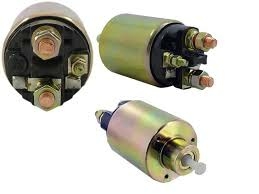Solenoids are mainly coils that are enfolded around a resolutely packed helix. When explained in terms of physical science, it is also a coil whose length is actually greater than its diameter and the coil is enveloped around a metallic core that produces a smooth magnetic field at the time when electric current moves through the solenoid. At several cases, the purpose of solenoids is to restrict the fluctuations in the electric current. It is then instead of electromagnet, it is referred to as an inductor. However, it should be noted that not all electromagnets and inductors are solenoids.
Coming to automotive solenoids, it may be employed for a broad range of purposes such as automatic transmission and for starting the car. A solenoid in automobiles is a crucial piece of the starter and it functions as a sort of contact for power to reach the starter from the respective battery. As the generation of vehicles is expanding at an enduring rate, so is the interest of manufacturers’ solenoids. Another factor that is probably going to pick up force is the utilization of solenoid in the programmed transmission of automobiles. Contemporary programmed transmission autos utilize a water driven liquid under pressure with a specific end goal to change gears. The trend of engine downsizing is also expected to gain traction in the years ahead, thus benefitting the market in return.
source: SBwire news
A solenoid is a coil that is wrapped around a firmly packed helix. In physical science, solenoid is a coil, the length of which is considerably larger than its diameter, wrapped round a metallic core that generates an even magnetic field in space when electric current passes through the solenoid. It is a kind of electromagnet, the purpose of which is to produce a meticulous magnetic field. Sometimes the function of solenoids is to inhibit the alterations in the electric current; the solenoid is then called an inductor, and not an electromagnet.However, not all inductors and electromagnets are solenoids.
An automobile solenoid may be used for a variety of purposes including car start and automatic transmission. A solenoid in cars is a vital part of the starter and it works as a kind of liaison for electricity to reach thestarter from the battery. As the production of vehicles are increasing at a steady rate, so is the demand for solenoid. According to OICA, 94,976,569 cars were produced in 2016, a 4.6% rise from the 2015 figures of 90,780,583 cars. Therefore, the automotive solenoid market is likely to gain traction in the coming years owing to the increasing demand for cars.
Another factor that is likely to gain momentum is the use of solenoid in the automatic transmission of cars. Contemporary automatic transmission cars use a hydraulic fluid under pressure in order to change gears. Each time a gear is changed, the car’s computer system activates a solenoid (transmission), which then directs the transmission fluid into the body of the valve in order to employ the right gear. As the need for automatic transmission is increasing around the globe, the market for automotive solenoid is poised to grow at a considerable rate as well.
The global automotive solenoid market is segmented on the basis of function, vehicle type, application, and geography. By function, the market is segregated into fluid control, gas control, and motion control. The motion control segment in the global automotive solenoid market owing to the growing prevalence of automation of body control applications in a vehicle. In terms of vehicle type, the market can be divided into passenger vehicles, commercial vehicles, and electric vehicles. The passenger vehicles segment accounted for the maximum market share of the market in 2016 owing to high number of passenger vehicles and in every vehicle, automotive solenoids are used. The electric vehicle segment is likely to as the use of solenoid in electric vehicles cars is gaining momentum owing to high number of solenoids being used per car. Based on application, the market is classified into engine control and cooling system, fuel and emission control, body control and interiors, HVAC system, safety and security, others. The body control and interiors sectorheld the maximum market share in 2016 owing to its varied applications in all passenger vehicle as well as commercial vehicles and the incorporation of the same from the manufacturers’ end.
In terms of geography, the global automotive solenoidmarket can be segmented into North America, Europe, Asia Pacific, Latin America,and Middle East &Africa.Asia Pacific is likely to dominate the global market during the forecast period. The region consistsof some of the major developing countries including India,China, and South Korea. This has resulted intoa rise in automotive solenoid volumes, with original equipment manufacturers catering to both domestic and overseas demand.
Source: Transparency Market Research
































